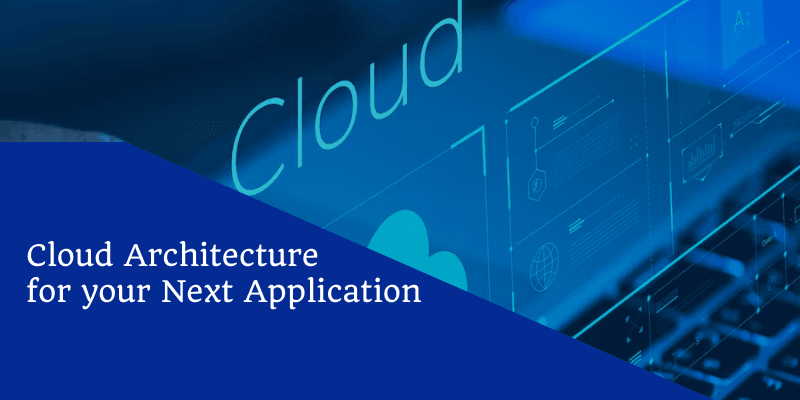Comprehensive Guide to Building a Robust Cloud Architecture for your Next Application

What is Cloud Architecture?
Cloud architecture is the blueprint for designing and deploying systems in the cloud that are scalable, secure, and reliable. It includes the resources, services, and components needed to run cloud application architecture efficiently in a virtual environment. In modern cloud architecture, the focus is on building systems that can easily handle changing workloads, scale as needed, and reduce the effort required to manage operations.
What is Cloud Application Development?
Cloud application development focuses on designing, building, and deploying software applications that run on cloud infrastructure. This practice includes using cloud-native technologies and tools to create systems that can seamlessly scale, offer high availability, and reduce upfront infrastructure costs. The process of building cloud applications demands careful attention to resource management, System Robustness, and automation.
Types of Cloud Applications
The modern cloud architecture supports different types of applications, including Software-as-a-Service (SaaS), Platform-as-a-Service (PaaS), and Infrastructure-as-a-Service (IaaS). Each type has its own set of advantages, offering businesses the flexibility to choose the most suitable option for their application.
.png&w=1920&q=75)
Why Do You Need a Cloud Application?
Building cloud applications helps businesses achieve scalability, agility, and cost savings. By leveraging the pay-as-you-go model, companies can scale resources dynamically, reduce hardware costs, and ensure high system availability.
Benefits of Cloud Application Development
Developing applications on the cloud brings key advantages:
- Scalability : Dynamically adjust resources as demand fluctuates.
- Reliability : Ensure your cloud infrastructure is designed for high availability.
- Cost Efficiency : The pay-as-you-go model allows businesses to only pay for the resources they use.
- Security : By following strong security principles, your cloud application design can ensure that sensitive data remains protected.
Key Considerations for Creating a Compatible Cloud Architecture
When building cloud application architecture, it’s essential to keep the following tips in mind to ensure compatibility, scalability, and operational efficiency:
Clearly define the goals, performance metrics, and resource needs for your cloud application. This helps in selecting the appropriate cloud services and designing a personalized architecture.
- Implement a Segmented Architecture:
Use microservices or serverless architecture to break down applications into smaller, independent components that can be developed, deployed, and scaled independently.
- Choose the Right Cloud Provider:
Choose a cloud provider based on your application’s scalability, security, pricing, and service needs. Compare options like AWS, Google Cloud, and Microsoft Azure, considering global availability, managed services, and compliance with industry standards. Ensure the provider supports tools essential for your app's growth.
- Choose the Right Cloud Service Model:
Decide between SaaS, PaaS, or IaaS based on your project’s requirements. Each service model offers varying levels of control, flexibility, and maintenance responsibilities.
- Utilize Managed Services:
Where possible, use cloud-managed services like databases, security services, and content delivery networks (CDNs) to offload infrastructure management and focus on your core application.
- Implement CI/CD Practices:
Continuous Integration and Continuous Deployment (CI/CD) pipelines ensure smooth deployment processes and quicker updates with minimal disruption. Automate CI/CD pipelines, resource management, and monitoring to ensure performance excellence and reduce human error.
- Build for Global Reach:
Deploy across multiple regions or availability zones to ensure your application has a wide footprint and is resilient to localized outages. This also enhances performance efficiency by reducing latency for users across different geographies.
- Focus on Scalability and Flexibility:
Use loose coupling principles to ensure that components in your architecture can be scaled independently and are not tightly interdependent. Start small but always design your system to scale both horizontally and vertically as demand increases. Use auto-scaling for compute resources and load balancing for even traffic distribution.
- Adopt Automation Practices:
Automate infrastructure as code (IaC) using tools like Terraform or AWS CloudFormation, ensuring reproducibility and reducing the likelihood of configuration drift.
- Build Security Into the Architecture:
Implement identity and access management (IAM), encryption, and security auditing from the start. Regularly assess and update security measures to adapt to evolving threats and compliance requirements.
- Prioritize Observability:
Focus on logging, monitoring, and tracing from the start, providing observability across your system so you can quickly detect and resolve issues.
- Prepare for Disaster Recovery and Failover:
Ensure that your architecture includes fault tolerance and multi-region deployments to handle unexpected outages with minimal downtime.
- Aim for Cost Efficiency:
Choose the appropriate pay-as-you-go model and use features like auto-scaling to optimize cloud costs.
.png&w=1920&q=75)
Primary Components of Cloud Architecture
- Compute Resources:
These are virtual machines or containers that run your applications. They provide the computational power needed to execute operations.
Example: AWS EC2, Google Compute Engine, Azure VMs
- Storage Solutions:
Cloud-based storage services that allow you to store and retrieve data dynamically.
Example: Amazon S3, Google Cloud Storage, Azure Blob Storage
- Networking:
Cloud networking allows secure and efficient communication between different cloud services, components, and external clients.
Example: Virtual Private Cloud (VPC), Load Balancers, DNS services
- Database Services:
Managed database solutions that handle data storage, retrieval, and indexing.
Example: AWS RDS, Google Cloud SQL, Azure Cosmos DB
- Security and Identity Management:
Tools and services for managing access, encryption, and user authentication.
Example: AWS IAM, Google Cloud IAM, Azure Active Directory
- Monitoring and Automation Tools:
These services enable real-time monitoring, alerts, and automated responses to incidents.
Example: AWS CloudWatch, Google Stackdriver, Azure Monitor
.png&w=128&q=75)